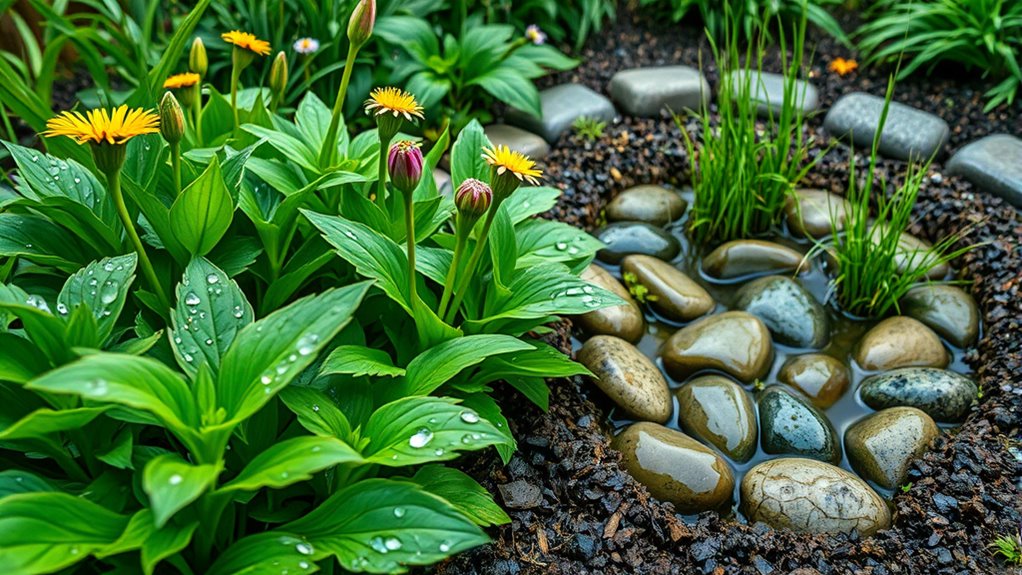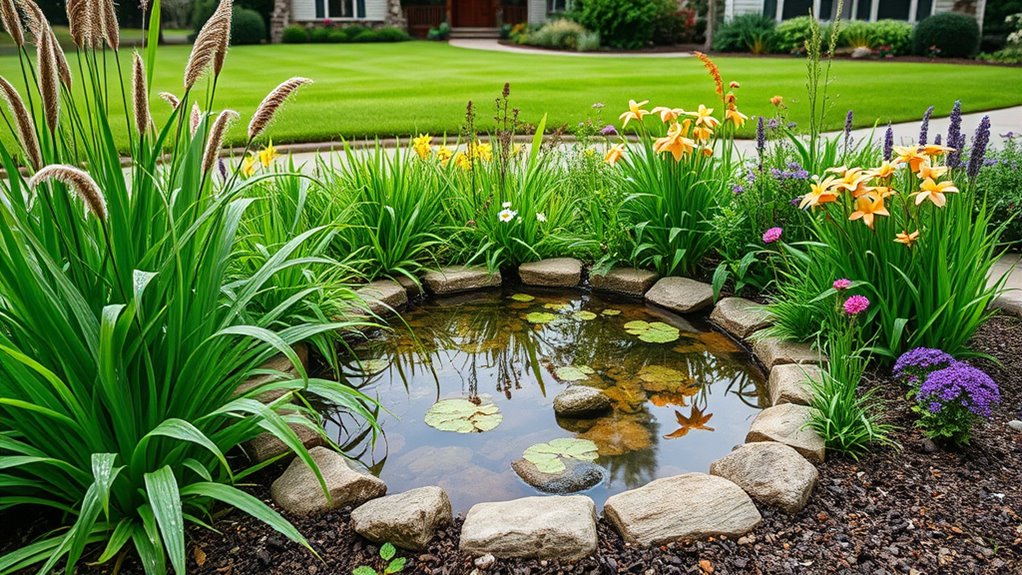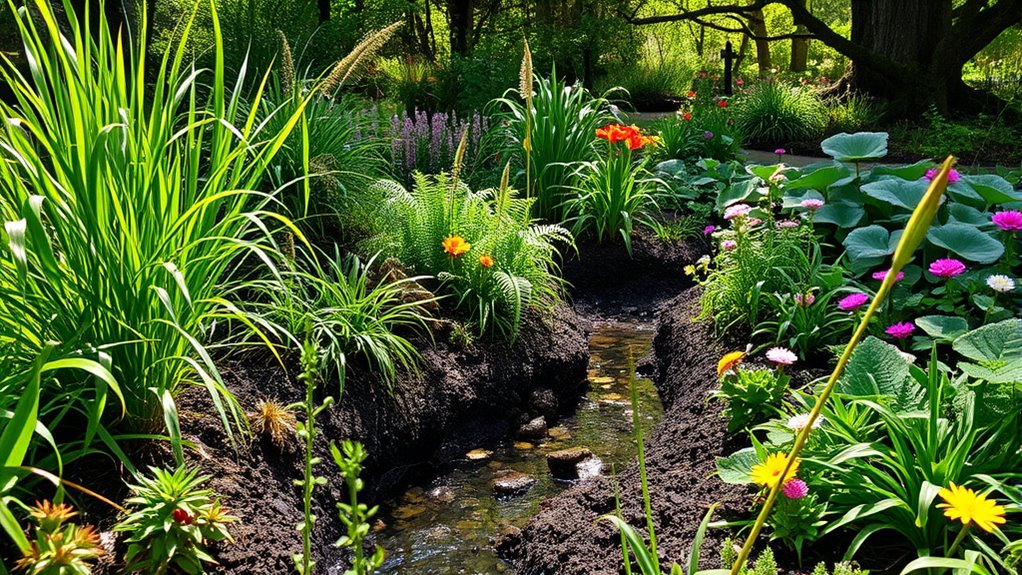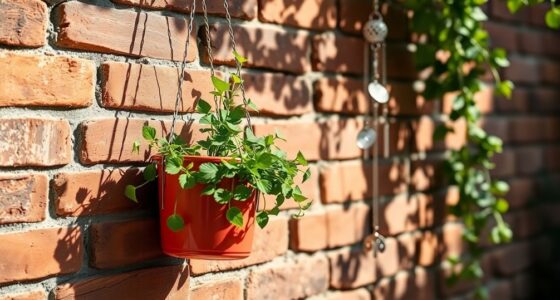A rain garden helps you manage runoff, reduce floods, and improve water quality by filtering pollutants before they reach lakes and rivers. It also enhances your yard’s look with native plants that require less maintenance and attract pollinators. Creating one involves choosing a suitable spot, preparing the soil, and selecting water-tolerant native plants. Keep in mind, proper design and regular care make your rain garden both beautiful and effective—discover more tips to make yours a success.
Key Takeaways
- Rain gardens reduce flooding, filter pollutants, and improve water quality by capturing stormwater runoff naturally.
- Select a suitable area, prepare soil, and install native, water-tolerant plants for effective rain garden setup.
- Use proper design principles, shape the depression to hold water temporarily, and incorporate gravel for drainage.
- Native plants require less maintenance, support local pollinators, and thrive in moist conditions for sustainability.
- Regularly monitor, weed, and water during dry spells to ensure your rain garden functions effectively and lasts long-term.
The Environmental and Practical Advantages of Rain Gardens

Rain gardens offer both environmental and practical benefits that can improve your outdoor space and local ecosystem. They excel at stormwater management by capturing runoff and reducing flooding, preventing water from overwhelming sewer systems. Using native plants in your rain garden enhances its effectiveness, as these species are adapted to local conditions and require less maintenance. Native plants also provide essential habitat for pollinators and wildlife. Additionally, rain gardens filter pollutants from stormwater, improving water quality before it reaches lakes and rivers. This eco-friendly approach not only protects the environment but also adds beauty and functionality to your yard. Incorporating rain garden design principles can optimize water absorption and plant health. By implementing a rain garden, you contribute to a healthier ecosystem while enjoying a more attractive outdoor space.
Step-by-Step Guide to Creating Your Own Rain Garden

Creating your own rain garden is a manageable project that can substantially improve your property’s drainage and beauty. Start by selecting the right location—preferably an area that naturally collects runoff. Next, prepare the soil by loosening it and enhancing drainage with organic matter or sand. Focus on plant selection by choosing native, water-tolerant species that thrive in moist conditions. Dig a shallow depression, shaping it to hold water temporarily. Install a layer of gravel at the bottom for extra drainage. Finally, plant your chosen species, ensuring they’re spaced appropriately. Regular maintenance, like weeding and watering during dry spells, will keep your rain garden healthy. Incorporating proper design principles can optimize its effectiveness and longevity. With these steps, you’ll create a sustainable, attractive feature that benefits your landscape and environment.
Frequently Asked Questions
How Much Does a Rain Garden Typically Cost to Install?
When considering the cost of installing a rain garden, you should do a thorough cost analysis to understand expenses. Typically, installation costs range from $2,000 to $5,000, depending on size and complexity. Using effective installation tips can help you save money and ensure proper setup. Keep in mind that investing in quality materials and professional guidance can improve the garden’s longevity and environmental benefits, making it a worthwhile expense.
Can I Build a Rain Garden on a Slope?
You can build a rain garden on a slope, but you need to consider placement carefully. Make certain the slope is stable to prevent erosion and water runoff issues. Position the garden at the slope’s base or where water naturally flows to maximize absorption. Avoid steep slopes, as they can compromise slope stability. Proper design and soil selection will help your rain garden function effectively without causing erosion or drainage problems.
What Plants Are Best Suited for Rain Gardens?
Choosing the right plants is like selecting the orchestra for a symphony. Native plants are your best performers—they thrive naturally and require less maintenance. Focus on soil selection, ensuring it’s well-draining yet moisture-retentive, to support healthy growth. Plants like swamp milkweed, purple coneflowers, and sedges suit rain gardens well, absorbing runoff and adding beauty. These selections help your rain garden flourish while supporting local ecosystems.
How Much Maintenance Does a Rain Garden Require?
You’ll find that a rain garden requires moderate maintenance to stay healthy. You should establish a regular maintenance schedule, including removing weeds, deadheading plants, and checking for erosion or standing water. Rain garden planting with native, drought-tolerant plants makes upkeep easier. Typically, you’ll need to inspect it seasonally and after heavy storms, but with consistent care, your rain garden will thrive and effectively manage stormwater runoff.
Will a Rain Garden Attract Mosquitoes?
Imagine a gentle pond in your yard, quietly holding rainwater. While it might seem like a mosquito magnet, a well-designed rain garden actually helps with stormwater management and mosquito prevention. Standing water is minimized, reducing breeding spots. Regular maintenance guarantees no stagnant pools form. So, with proper planning and upkeep, your rain garden becomes a beautiful, functional feature that manages stormwater effectively without attracting pesky mosquitoes.
Conclusion
Now that you know how to craft your own rain garden, you’re not just planting a garden—you’re becoming a steward of the environment, much like the ancient gardeners of Babylon. With each rain, your garden will soak up runoff and support local wildlife. So, grab your shovel and start today; your future self will thank you. Remember, even in an age of progress, simple acts like this can make a mighty difference.









